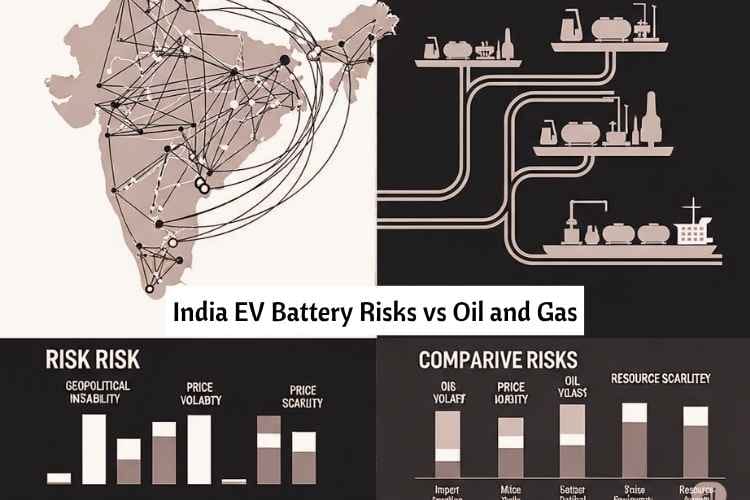India EV Battery Risks vs Oil and Gas: India is aiming high. With the government pushing for EV adoption, cleaner air, and reduced oil imports, the EV market is accelerating fast. By 2030, the country wants 30% of all vehicles to be electric.
That’s where the recent remarks by the NITI Aayog CEO become crucial. According to him, while no energy solution is risk-free, the risks of EVs are “less dangerous and more manageable” than those tied to oil and gas. Let’s explore that further.

Table of Contents
India EV Battery Risks vs Oil and Gas Risks – A Comparative Overview

| Risk Factor | EV Battery Industry | Oil & Gas Sector |
|---|---|---|
| Fire Hazards | Battery fires occur, often during charging; rare but high-profile | Frequent pipeline leaks, refinery explosions, and tanker fires |
| Environmental Impact | Oil spills, emissions, and groundwater contamination | Political instability in oil-rich countries, OPEC control |
| Supply Chain Risks | High reliance on China for rare earth materials | Air pollution, carcinogens, and smog from fuel combustion |
| Health Hazards | Manufacturing exposure to metals; e-waste issues | India imports ~85% of its oil, which poses a high trade imbalance risk |
| Geopolitical Dependency | Sourcing minerals from select countries | India imports ~85% of its oil, which poses a high trade imbalance risk |
| Lifecycle Emissions | Cleaner over time (esp. with renewable electricity) | Mining for lithium/cobalt has a local environmental impact |
What the NITI Aayog CEO Said
In May 2025, during a national conference on sustainable energy, B.V.R. Subrahmanyam remarked:
“The risks associated with EVs — such as battery fires — are far less catastrophic than the decades of health and environmental damage caused by oil and gas.”
He emphasised three key points:
- Oil & Gas is a legacy hazard – “From oil spills to toxic air, the damage is widespread and irreversible in many cases.”
- EV issues are isolated and improvable – “Battery safety tech is rapidly evolving.”
- India must control the EV value chain, including battery recycling, local mineral sourcing, and domestic cell manufacturing.
Conclusion on India EV Battery Risks vs Oil and Gas
While EV batteries come with challenges, they’re not as systemically destructive as the oil and gas legacy. The risks are more controllable, technologically addressable, and less harmful to human health.
The NITI Aayog CEO’s statement reflects a hard truth: We’ve accepted oil’s dangers for far too long. It’s time to embrace smarter, safer alternatives. EVs aren’t perfect, but they’re progress.
As India continues to build battery supply chains, develop EV infrastructure, and invest in green jobs, the real risk lies in not acting fast enough.
Bhakti Rawat is a Founder & Writer of InsureMyCar360.com. This site Provides You with Information Related To the Best Auto Insurance Updates & comparisons. 🔗
